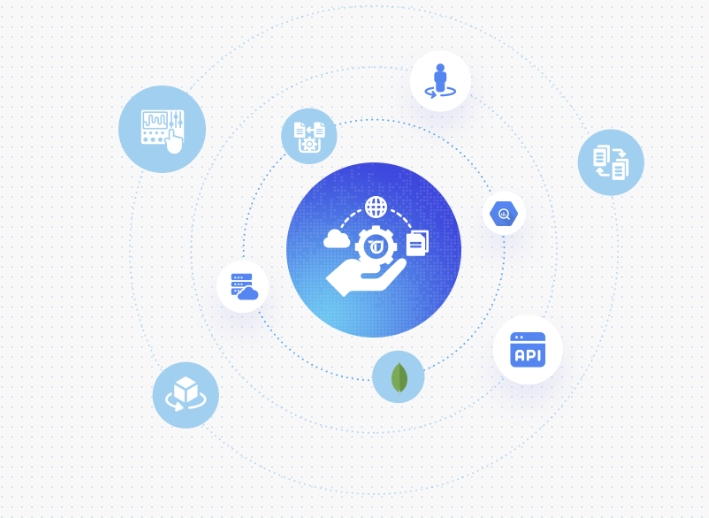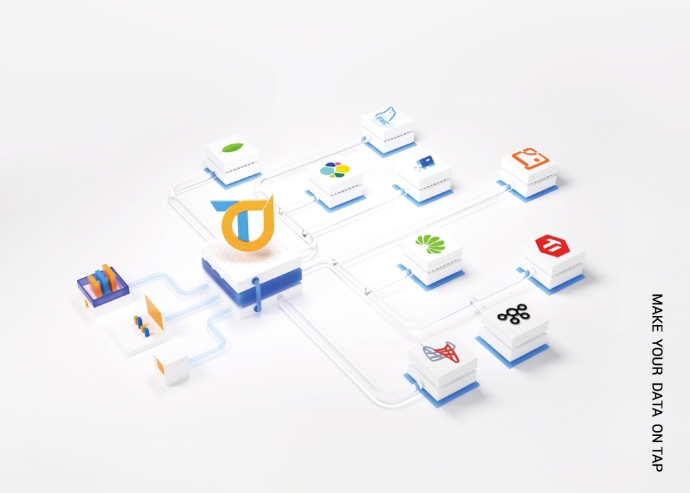Unlocking the Power of Real-Time Data Synchronization in a Cloud Data Warehouse
Introduction
Tapdata Cloud is a cutting-edge data movement platform that offers real-time data integration and services, revolutionizing the way businesses handle their data. With its low-latency capabilities and 100+ built-in connectors, Tapdata Cloud enables seamless connectivity between various sources, both on-premises and in the cloud. This empowers businesses to make informed decisions based on real-time insights, improving overall efficiency and productivity.
Real-time data synchronization plays a pivotal role in unlocking the full potential of a cloud data warehouse. It refers to the process of continuously updating and transferring data from multiple sources to a central repository in real time. This ensures that the most up-to-date information is readily available for analysis and decision-making.
In today's fast-paced business environment, timely access to accurate data is crucial for making informed decisions. Traditional methods of batch processing or periodic updates often result in outdated information being used for critical decision-making processes. Real-time data synchronization eliminates this issue by providing immediate access to the most current data available.

By consolidating data from various sources into a cloud data warehouse through real-time synchronization, businesses can achieve better consistency and accuracy. Data consolidation involves combining different datasets into one centralized location, eliminating redundancies and inconsistencies that may arise from using multiple databases or systems. This not only improves the quality of the data but also enhances its reliability for analysis purposes.
Furthermore, with real-time data synchronization, businesses can leverage cross-platform analytics to enhance collaboration and decision-making processes. By integrating data from different platforms such as CRM systems, marketing automation tools, or social media platforms, teams can gain a comprehensive view of their business operations. This allows for better collaboration between departments and enables more accurate forecasting and planning.
Data Consolidation for Better Consistency and Accuracy
Data consolidation is a crucial process that plays a significant role in ensuring better consistency and accuracy of data in a cloud data warehouse. By consolidating data from various sources into a single, centralized repository, businesses can avoid data inconsistencies and discrepancies that may arise from using multiple databases or siloed systems.
One of the key benefits of data consolidation is improved data consistency. When data is scattered across different databases or systems, it becomes challenging to maintain uniformity and standardization. Inconsistent data can lead to confusion and errors in decision-making processes. However, by consolidating all relevant data into a cloud data warehouse, organizations can ensure that everyone has access to the same set of accurate and up-to-date information.
Another advantage of data consolidation is enhanced data accuracy. When information is stored in multiple locations or systems, there is a higher chance of encountering duplicate or conflicting records. This can result in inaccuracies and discrepancies that can have serious implications for business operations. By consolidating the data into a single source of truth, businesses can eliminate duplicates, resolve conflicts, and maintain a high level of accuracy across their datasets.
Furthermore, consolidating data also enables organizations to establish robust data governance practices. With all the relevant information stored in one place, it becomes easier to implement standardized processes for data management, quality control, and security. This ensures that the right people have access to the right information at the right time while maintaining compliance with regulatory requirements.
Timely Decision-Making with Real-Time Data Synchronization
In today's fast-paced business environment, making timely decisions is crucial for staying ahead of the competition. Real-time data synchronization plays a significant role in enabling businesses to make informed decisions based on the most up-to-date information available. By ensuring that data is synchronized in real-time across various sources and systems, businesses can access accurate and current insights, enabling them to respond quickly to market changes and make better-informed decisions.
One of the key benefits of real-time data synchronization for decision-making is the ability to access up-to-date information. Traditional data warehouses often suffer from delays in data updates, which can result in outdated insights and hinder decision-making processes. With real-time data synchronization, businesses can eliminate these delays and have immediate access to the latest data from multiple sources. This allows decision-makers to have a comprehensive view of their business operations and make well-informed decisions based on current market trends.
Another advantage of real-time data synchronization is the ability to respond quickly to market changes. In today's dynamic business landscape, market conditions can change rapidly, requiring businesses to adapt their strategies accordingly. Real-time data synchronization enables businesses to monitor changes in customer preferences, industry trends, and competitive landscapes as they happen. This allows decision-makers to identify emerging opportunities or potential risks promptly and adjust their strategies accordingly.
Furthermore, real-time data synchronization facilitates better collaboration among teams by providing a single source of truth for all stakeholders involved in the decision-making process. With cross-platform analytics capabilities offered by cloud-based data warehouses like Tapdata Cloud, teams can collaborate more effectively by accessing and analyzing synchronized data from different sources simultaneously. This not only improves communication but also ensures that everyone has access to consistent and accurate information when making critical business decisions.
Cross-Platform Analytics for Improved Collaboration and Decision-Making
Cross-platform analytics is a powerful tool that enables improved collaboration and decision-making within organizations. By integrating data from various sources and platforms, businesses can gain valuable insights and make informed decisions to drive growth and success.
One of the key advantages of cross-platform analytics is the increased collaboration among teams. With data consolidated in a cloud data warehouse through real-time synchronization, employees from different departments can access and analyze the same set of information. This eliminates silos and promotes a culture of collaboration, as everyone can work together towards common goals.
By having access to real-time data from multiple sources, businesses can make better-informed decisions. Cross-platform analytics allows for comprehensive analysis by combining data from different systems, such as sales, marketing, finance, and customer support. This holistic view provides a deeper understanding of business operations and customer behavior, enabling organizations to identify trends, patterns, and opportunities that may have otherwise gone unnoticed.
Furthermore, cross-platform analytics facilitates faster decision-making processes. Real-time data synchronization ensures that insights are up-to-date and readily available when needed. This eliminates the need for manual data extraction or time-consuming reporting processes. With timely access to accurate information, businesses can respond quickly to market changes, address emerging issues promptly, and seize new opportunities before their competitors.
In addition to improving collaboration and decision-making, cross-platform analytics also enhances the overall efficiency of an organization. By leveraging real-time data synchronization in a cloud data warehouse like Tapdata Cloud, businesses can streamline their operations and reduce costs associated with manual data integration. The platform's built-in connectors enable seamless integration with various sources without requiring extensive coding or IT resources.
Flexible Billing Options for Tailored Solutions
Flexible billing options are a key feature of Tapdata Cloud, providing businesses with tailored solutions to meet their specific needs. With the ability to choose from different plans, organizations can select the option that aligns best with their budget and requirements. This flexibility ensures that businesses are not paying for unnecessary features or services, resulting in cost-effective solutions.
Tapdata Cloud offers a range of plans to accommodate various data integration and synchronization needs. Whether a business requires basic real-time data movement or advanced cross-platform analytics, there is a plan that suits their specific use case. The availability of different tiers allows businesses to scale up or down as needed, ensuring they only pay for what they require.
By offering flexible billing options, Tapdata Cloud empowers businesses to optimize their data warehouse usage and costs. This level of customization enables organizations to allocate resources efficiently and effectively, maximizing the value derived from their data.
In addition to cost-effectiveness, flexible billing options also provide businesses with the freedom to experiment and explore new functionalities without committing to a long-term contract. This agility allows organizations to adapt quickly to changing business needs and market conditions.

Conclusion
In conclusion, the benefits of real-time data synchronization in a cloud data warehouse are undeniable. By harnessing the power of Tapdata Cloud, businesses can make informed decisions with timely insights, improve collaboration with cross-platform analytics, and ensure better data consistency and accuracy through data consolidation. With real-time data synchronization, organizations can stay ahead of their competition by accessing up-to-date information and responding quickly to market changes.
Tapdata Cloud offers a comprehensive solution for businesses seeking a reliable and efficient data warehouse platform. Its low-latency data movement capabilities enable seamless integration with various sources, both on-premises and in the cloud. The platform's 100+ built-in connectors make it easy to connect with different systems, eliminating the need for complex integrations.
Furthermore, Tapdata Cloud provides flexible billing options that allow users to choose the plan that best suits their needs. This ensures that businesses only pay for the services they require, optimizing cost-efficiency without compromising on functionality.
To unlock the full potential of real-time data synchronization in a cloud data warehouse, businesses should consider exploring Tapdata Cloud as their preferred solution. With its user-friendly interface, robust features, and reliable performance, Tapdata Cloud empowers business owners, data analysts, and IT professionals to leverage real-time insights for strategic decision-making.
In today's fast-paced business environment, having access to accurate and up-to-date information is crucial for success. Real-time data synchronization not only enables timely decision-making but also promotes better collaboration and improved accuracy in analytics. By choosing Tapdata Cloud as your data warehouse platform, you can harness the power of real-time data synchronization and unlock new possibilities for your business. So why wait? Start your journey towards a more efficient and effective data management strategy with Tapdata Cloud today!
See Also
Harnessing the Potential of Real-Time Operational Analytics through Data as a Service
Unleashing the Potential of Real-Time Processing: Advantages and Benefits
Instant Data Insights Unleashed: The Power of Real-Time Processing
Real-Time Empowerment: Unleashing the Potential of Customer 360

